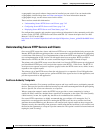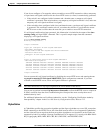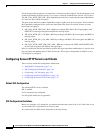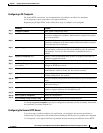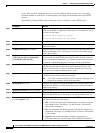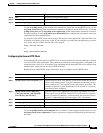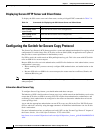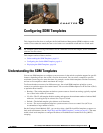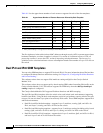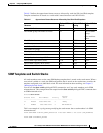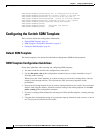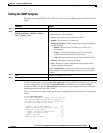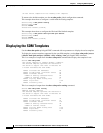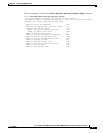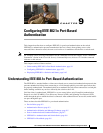
8-2
Cisco Catalyst Switch Module 3110 and 3012 for IBM BladeCenter Software Configuration Guide
OL-12189-01
Chapter 8 Configuring SDM Templates
Understanding the SDM Templates
Table 8-1 lists the approximate numbers of each resource supported in each of the four templates.
The first eight rows in the tables (unicast MAC addresses through security ACEs) represent approximate
hardware boundaries set when a template is selected. If a section of a hardware resource is full, all
processing overflow is sent to the CPU, seriously impacting switch performance. The last row is a
guideline used to calculate hardware resource consumption related to the number of Layer 2 VLANs on
the switch.
Dual IPv4 and IPv6 SDM Templates
You can select SDM templates to support IP Version 6 (IPv6). For more information about IPv6 and how
to configure IPv6 host functions and unicast routing, see Chapter 39, “Configuring IPv6 Host Functions
and Unicast Routing.”
This software release does not support IPv6 multicast routing and QoS on the Catalyst Switch
Module 3110.
This software release does not support policy-based routing (PBR) when forwarding IPv6 traffic on the
Catalyst Switch Module 3110. The software supports IPv4 PBR only when the dual-ipv4-and-ipv6
routing template is configured.
The Catalyst Switch Module 3012 supports IPv6 host functions and MLD snooping.
The dual IPv4 and IPv6 templates allow the switch to be used in dual stack environments (supporting
both IPv4 and IPv6). Using the dual stack templates results in less hardware capacity allowed for each
resource. Do not use them if you plan to forward only IPv4 traffic. These SDM templates support IPv4
and IPv6 environments:
• Dual IPv4 and IPv6 default template—supports Layer 2, multicast, routing, QoS, and ACLs for
IPv4; and Layer 2, routing, and ACLs for IPv6 on the switch.
• Dual IPv4 and IPv6 routing template—supports Layer 2, multicast, routing (including policy-based
routing), QoS, and ACLs for IPv4; and Layer 2, routing, and ACLs for IPv6 on the switch.
• Dual IPv4 and IPv6 VLAN template—supports basic Layer 2, multicast, QoS, and ACLs for IPv4,
and basic Layer 2 and ACLs for IPv6 on the switch.
Table 8-1 Approximate Number of Feature Resources Allowed by Each Template
Resource Access Default Routing VLAN
Unicast MAC addresses 4 K 6 K 3 K 12 K
IGMP groups and multicast routes 1 K 1 K 1 K 1 K
Unicast routes 6 K 8 K 11 K 0
• Directly connected hosts 4 K 6 K 3 K 0
• Indirect routes 2 K 2 K 8 K 0
Policy-based routing ACEs
1
1. Policy-based routing is not supported on the Catalyst Switch Module 3012.
0.5 K 0 0.5 K 0
QoS classification ACEs 0.5 K 0.5 K 0.5 K 0.5 K
Security ACEs 2 K 1 K1 K1 K
VLANs 1 K 1 K1 K1 K



